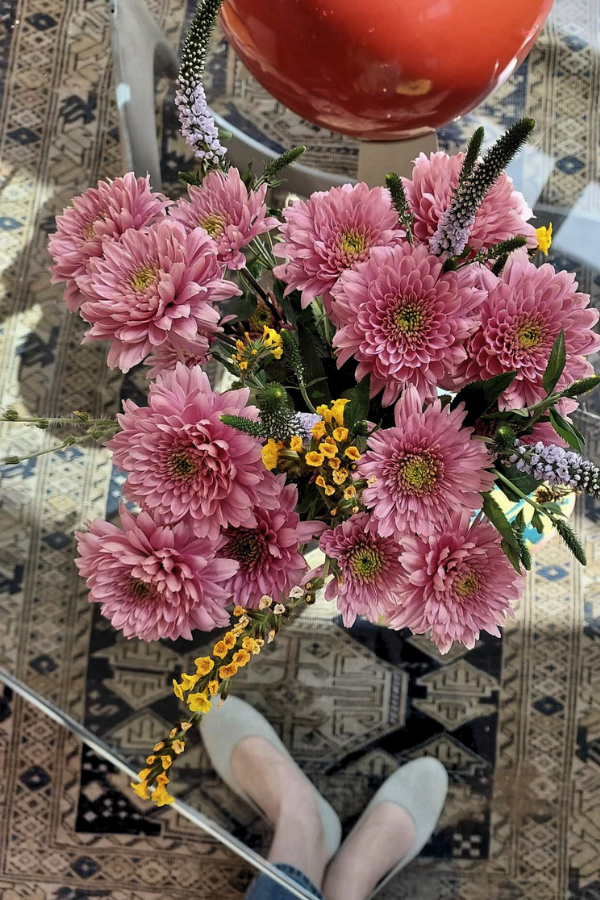

How to Cut Flowers for Lovely, Long-Lasting Arrangements
Summary
Reflection Questions
Journal Prompt
Flowers have the power to transform our spaces and mood, adding a burst of color, fragrance, and beauty to our daily lives. They are symbols of love, sympathy, and celebration, enhancing every occasion with their natural elegance. This article aims to guide readers through the process of cutting flowers properly for arrangements and sharing expert tips on how to preserve these floral displays for as long as possible. Whether you’re a gardening enthusiast or simply enjoy having fresh flowers in your home, mastering these techniques will ensure your arrangements stay vibrant and fresh, prolonging the joy they bring into your life.
The DesignDash Guide to Creating Arrangements from Fresh Cut Flowers
Preparing to Cut Fresh Flowers
The best time to cut flower stems is in the early morning or late evening when temperatures are cooler, and plants are well-hydrated. This ensures the flowers have the highest water content and are less likely to wilt immediately after cutting. Additionally, choosing flowers that are just beginning to open or are in the bud stage can significantly extend the longevity of your arrangements, as they will continue to bloom and mature after being placed in water.
Tools You’ll Need
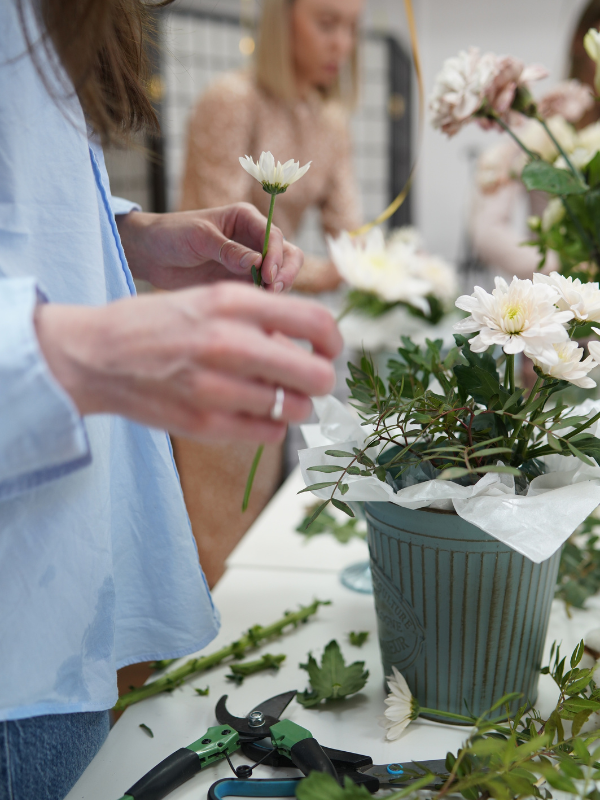

Having the right tools is crucial for cutting flowers without causing damage to their stems or your plants. A clean pair of sharp scissors or pruning shears is essential for making clean cuts that allow the flower to absorb water efficiently. With most flowers, a sharp knife just won’t cut it.
Additionally, having a clean bucket of warm water on hand to place the stems in immediately after making fresh cuts will prevent air bubbles from entering the stem and blocking water uptake. Warm tap water also helps flowers uptake nutrients from plant food faster. From roses to lilies, a tablespoon of lemon juice added to either hot water or cold water can also help the flowers last. (No one wants dying flowers a couple of days after placing them in vase water!)
Cutting Flowers Properly
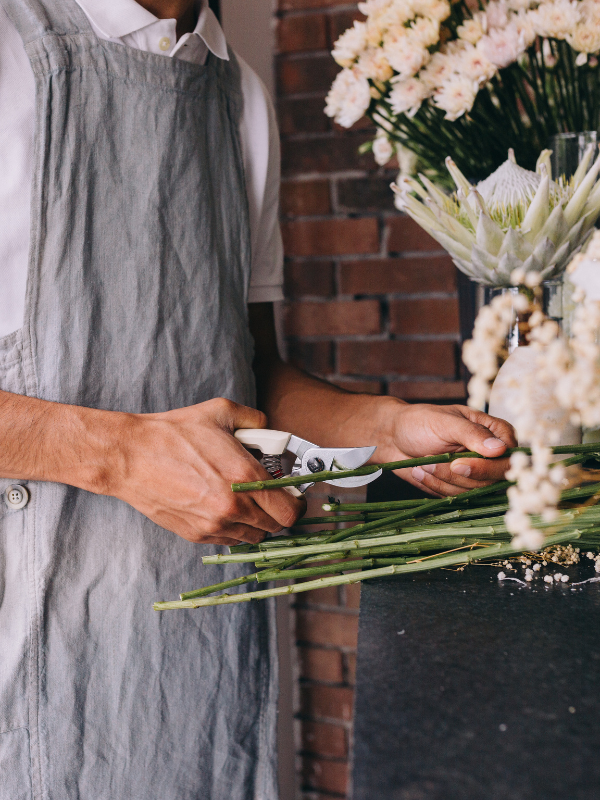

Cutting stems at a 45-degree angle is not just a florist’s tradition; it increases the surface area for water absorption and prevents the end of the stem from resting directly on the bottom of the vase, ensuring the flower can drink water more effectively. This technique, coupled with a swift, clean cut, minimizes damage and stress to the flower, helping it stay hydrated and fresh.
Immediate Care Post-Cutting
Immediately after cutting, rinse stems under running water and then place the stems in a bucket of lukewarm water to encourage water uptake. This quick transition is vital to prevent air embolisms that can block water from traveling up the stem to the bloom. Additionally, removing any leaves that will sit below the waterline in your vase will reduce bacterial growth and keep the water cleaner for longer.
Preparing the Arrangement
Selecting Your Vessel
Choosing the right vase or container for your arrangement is more than just a stylistic choice; it affects the longevity of your flowers. Ensure the vessel is clean and filled with fresh water mixed with a floral preservative to reduce bacteria and provide nutrients to the flowers. The size and shape of the vase should support the stems and allow enough space for air circulation among the blooms.
Arranging Basics


When arranging your flowers, start with a base of larger, sturdier blooms or foliage to create structure. Then, add in your focal flowers, balancing colors and sizes for aesthetic appeal. Use filler flowers or additional greenery to fill in gaps and create a lush, full look. Remember to regularly trim stems and change the water to keep your arrangement looking its best. Here are some specific tips to ensure your arrangements delight all season long.
Start Simple: Choose flowers with larger blooms as your main feature, such as roses, lilies, or dahlias. These can serve as the focal point around which you can add smaller, complementary flowers or greenery. Starting with a simple palette of colors or sticking to just one or two types of flowers can also make the process less overwhelming.
Use a Floral Foam: For more structured arrangements, consider using a block of floral foam. Soak the foam in water until it’s fully saturated, then place it in your vase or container. This will not only hold your stems in place but also provide them with continuous water, helping to keep them fresh.
Balance and Proportion: Pay attention to the height and width of your arrangement. A good rule of thumb is for the height of the flowers to be about one and a half to two times the height of the vase. Also, consider the space where the arrangement will sit; it should be proportionate to its surroundings and not overpower the space.
Texture Variation: Mix flowers of different textures to add depth and interest to your arrangement. Combine glossy and matte finishes, and smooth and spiky blooms, to create a visually appealing bouquet.
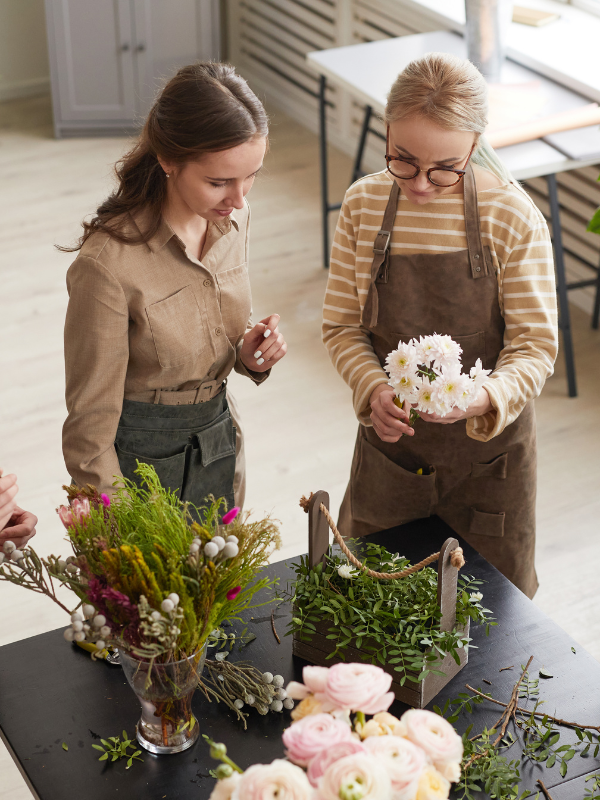

Color Theory: Use color theory to guide your selection. Complementary colors (those opposite each other on the color wheel) can create vibrant arrangements, while analogous colors (those next to each other on the color wheel) offer a more harmonious look.
Fillers are Your Friends: Don’t underestimate the power of fillers like baby’s breath, ferns, or eucalyptus. These can fill out your arrangement, adding volume and texture, and often contribute to the overall balance and shape of your bouquet.
Practice the Spiral Technique: When arranging flowers in a handheld bouquet or a vase, use the spiral technique. Hold your initial stem at a 45-degree angle, and as you add more stems, rotate the bouquet slightly in one direction. This creates a natural, spiraled look that’s common in professional bouquets.
Recut Stems: Before placing your flowers in water, recut the stems at an angle underwater if possible. This prevents air bubbles that can block water absorption and helps the flowers hydrate more efficiently.
Change Water Regularly: Keeping the water fresh and the container clean is crucial to extend the life of your arrangement. Change the water every two days, and give the stems a fresh cut at the same time to keep them absorbing water well.
Enjoy the Process: Don’t stress about making your arrangement perfect. Part of the beauty of floral arrangements comes from their natural, sometimes imperfect look. Experiment with different styles and compositions to find what you enjoy most.
Making Your Arrangements Last
Water Is Key
Maintaining clean, fresh water is crucial for extending the life of your floral arrangement. Change the water and clean the vase every two days, trimming the stems slightly each time to ensure they can absorb water effectively. This minimizes bacterial growth and keeps flowers hydrated.
Location, Location, Location
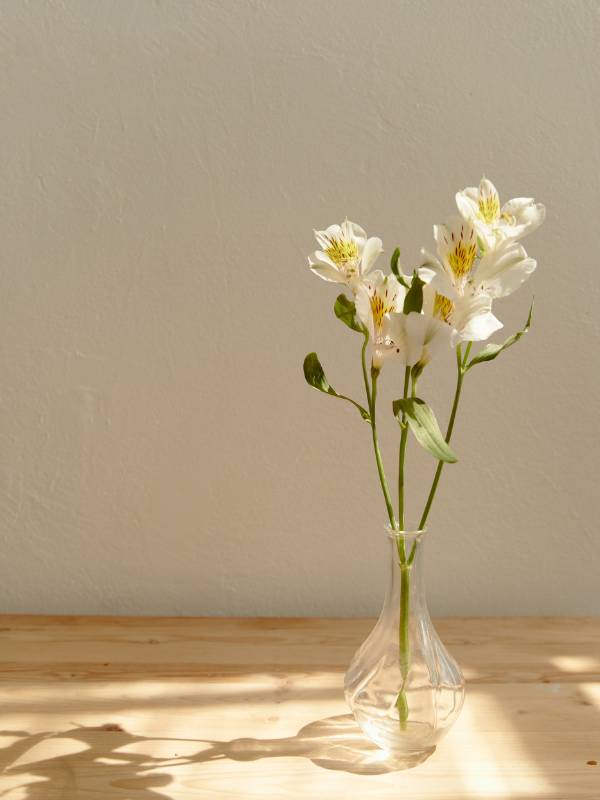

The placement of your flower arrangement can significantly impact its lifespan. Keep arrangements away from direct sunlight, drafts, and sources of heat or fruit, which can produce ethylene gas that accelerates wilting. A cool, stable environment will help your flowers last longer.
Daily Maintenance Tips
Daily care can greatly extend the life of your arrangement. Check the water level daily, remove any wilted or spent blooms to prevent bacterial growth, and trim the stems every few days to ensure optimal water uptake. Consider adding extra flower food if needed. These small efforts can make a big difference in the longevity of your flowers.
Additional Tips for Specific Flower Types


Different flowers have unique needs and may require specific care to thrive in arrangements. For example, woody stems like hydrangeas may need a longer initial cut to absorb water effectively, while delicate blooms like tulips benefit from minimal handling and cooler water. Researching and applying care tips tailored to each flower type in your arrangement will ensure all components flourish for as long as possible.
By mastering the art of cutting and caring for flowers, you can create stunning arrangements that bring lasting beauty and joy to your space. Whether you’re arranging a bouquet from your garden or a mix of store-bought flowers, these tips will help you maximize their lifespan, allowing you to savor the vibrant colors and delicate fragrances for days
Final Thoughts on Creating Stunning, Long-Lasting Bouquets
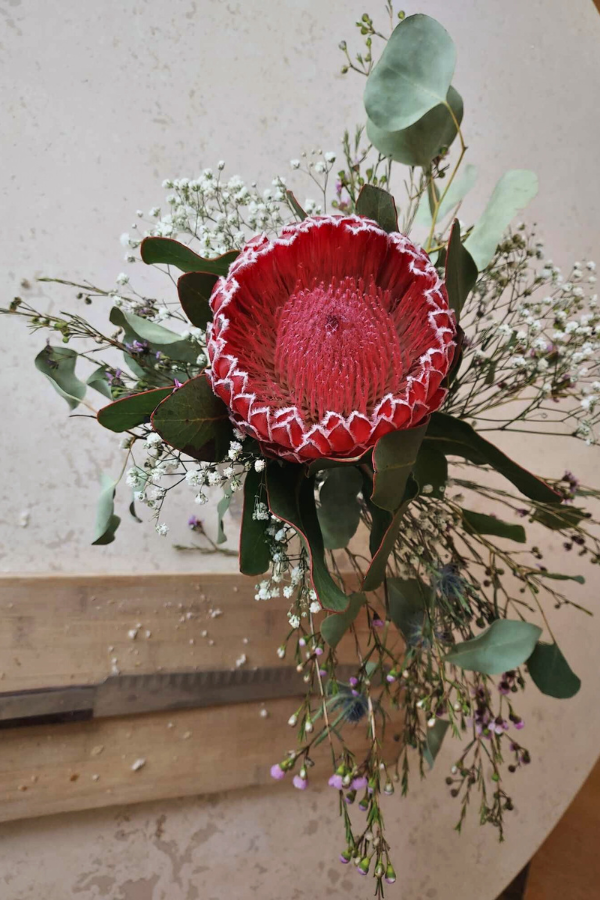

The art of flower arranging is not just about the aesthetic placement of flowers in a vase; it’s a meticulous craft that begins with the proper cutting of stems and extends to the diligent care of the arrangement to ensure it remains vibrant and fresh for as long as possible. Mastering the technique of cutting at the right angle, choosing the appropriate moment of the day for harvesting, and understanding the importance of immediate post-cut care are fundamental steps that set the foundation for a flourishing bouquet. Moreover, the ongoing maintenance of your floral arrangement, including regular water changes and strategic placement away from harmful environmental factors, plays a critical role in extending the life and beauty of your flowers.
Remember to relish in the process and the unique beauty that comes from arranging flowers. Whether it’s a simple bouquet for your dining table or an elaborate centerpiece for a special occasion, each creation is a reflection of your personal touch and the natural elegance of the flowers themselves. We encourage you to share the joy and beauty of your floral creations with us.
Send photos of your arrangements to our Editor-in-Chief, and let your blossoming talent inspire others within our community. Your contributions not only celebrate the enchanting world of flower arranging but also connect us all through the shared appreciation of nature’s splendor.








